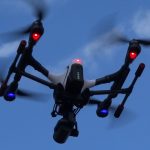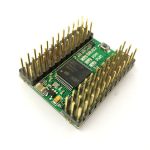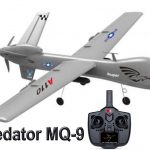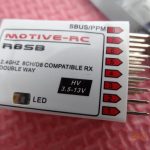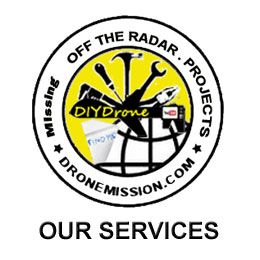Category Archives: Gears
RMILEC Signal Converter V3 SBus PWM PPM
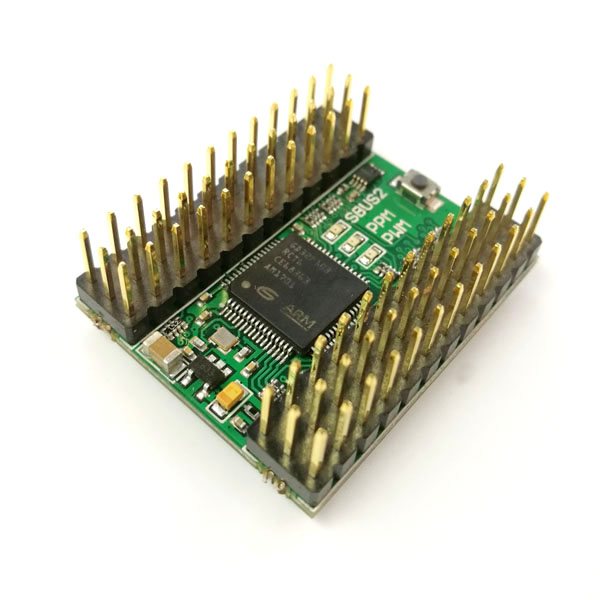
RMILEC Signal Converter Signal Analyzer V3. If you want to test or fly with a SBus receiver without a flight controller the old fashion way, you are in luck; this signal converter is able to convert SBus signal into PWM signal and two-way PPM signal. It can also convert PWM signal into PPM signal and SBUS signal, or convert two-way PPM signal into PWM signals and SBUS signals. Amazing! I will take some video to give you some ideas of what you can potentially use it for, probably more ideas than I can suggest.
 Besides debugging signals, we plan to use the FrSky R9 MM, the latest long-range 900MHz mini receiver on a plane, so one option is to use RMILEC signal converter and connect directly to each servo leads. The RMILEC Signal Converter carries a small footprint, about a size of a SD card. There is also an older version that incorporate a LiPo alarm of this converter, in that way it also function as a low voltage warning system…
Besides debugging signals, we plan to use the FrSky R9 MM, the latest long-range 900MHz mini receiver on a plane, so one option is to use RMILEC signal converter and connect directly to each servo leads. The RMILEC Signal Converter carries a small footprint, about a size of a SD card. There is also an older version that incorporate a LiPo alarm of this converter, in that way it also function as a low voltage warning system…
Motive-RC R8SB Telemetry Receiver on Taranis X-Lite
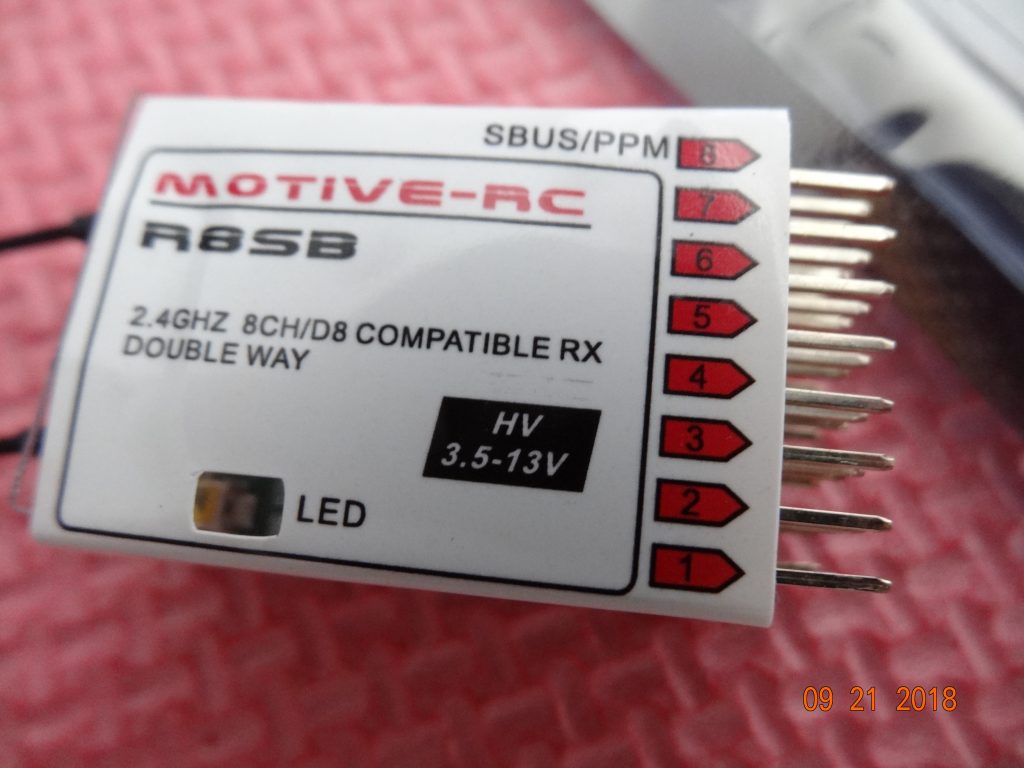
I still fly lots of planes the old school way, without any flight controllers, so this Motive RC R8SB all-in-one receiver even though a D8, it allows me to use my Taranis radio transmitter and most of the features. Add a voltage sensor and I am all set. The receiver comes with various model type SBUS, physical channel PWM outputs, PPM and RSSI. The RSSI warns me about the signal strength before I fly too far out. Here is a video on how I add a RSSI bar to my X-Lite screen using the Motive-RC R8SB.

 The R8SB is like the FrSky V8R7-II receiver but with telemetry functions. It bound instantly and lights up like a green lantern. There are more pins than a usual receiver, but they are nicely color coded to help me determine signal, power and ground. The upper set of pins are your 8 channels or SBUS/PPM. The lower set of pins are RSSI, two analog telemetry ports (A1&A2), A1 for internal receiver battery voltage sensor, A2 for external battery voltage sensor (0~30V, 1~6S) and one digital data-stream port (Rx, Tx)…
The R8SB is like the FrSky V8R7-II receiver but with telemetry functions. It bound instantly and lights up like a green lantern. There are more pins than a usual receiver, but they are nicely color coded to help me determine signal, power and ground. The upper set of pins are your 8 channels or SBUS/PPM. The lower set of pins are RSSI, two analog telemetry ports (A1&A2), A1 for internal receiver battery voltage sensor, A2 for external battery voltage sensor (0~30V, 1~6S) and one digital data-stream port (Rx, Tx)…
FrSky Taranis X-LITE Review Spring Unloaded
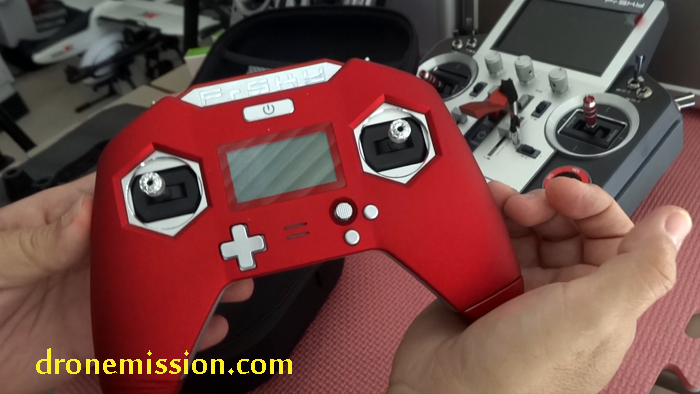
Introducing the FrSky Taranis X-LITE, the ultimate gaming radio transmitter. Made to match the ergonomic modern design of a gaming remote control, this radio transmitter has all the capabilities of a traditional radio and more.
One advantage of this FrSky radio is I can switch out to a R9M 900MHz frequency system for long range, low latency, going as far as 10 km.

 First impression is good, it is more refine than anticipated. The speaker sound is so much more superior than the Taranis X9D . Equipped with the latest M12 Lite hall sensor gimbals. Hall sensor gimbals are more precise and durable than traditional gimbals using potentiometers. The switches may feel a little too small, but for casual flying (not competitive racing), this radio does just fine…
First impression is good, it is more refine than anticipated. The speaker sound is so much more superior than the Taranis X9D . Equipped with the latest M12 Lite hall sensor gimbals. Hall sensor gimbals are more precise and durable than traditional gimbals using potentiometers. The switches may feel a little too small, but for casual flying (not competitive racing), this radio does just fine…
FXT Mars S T71 Micro FPV Camera 1000TVL
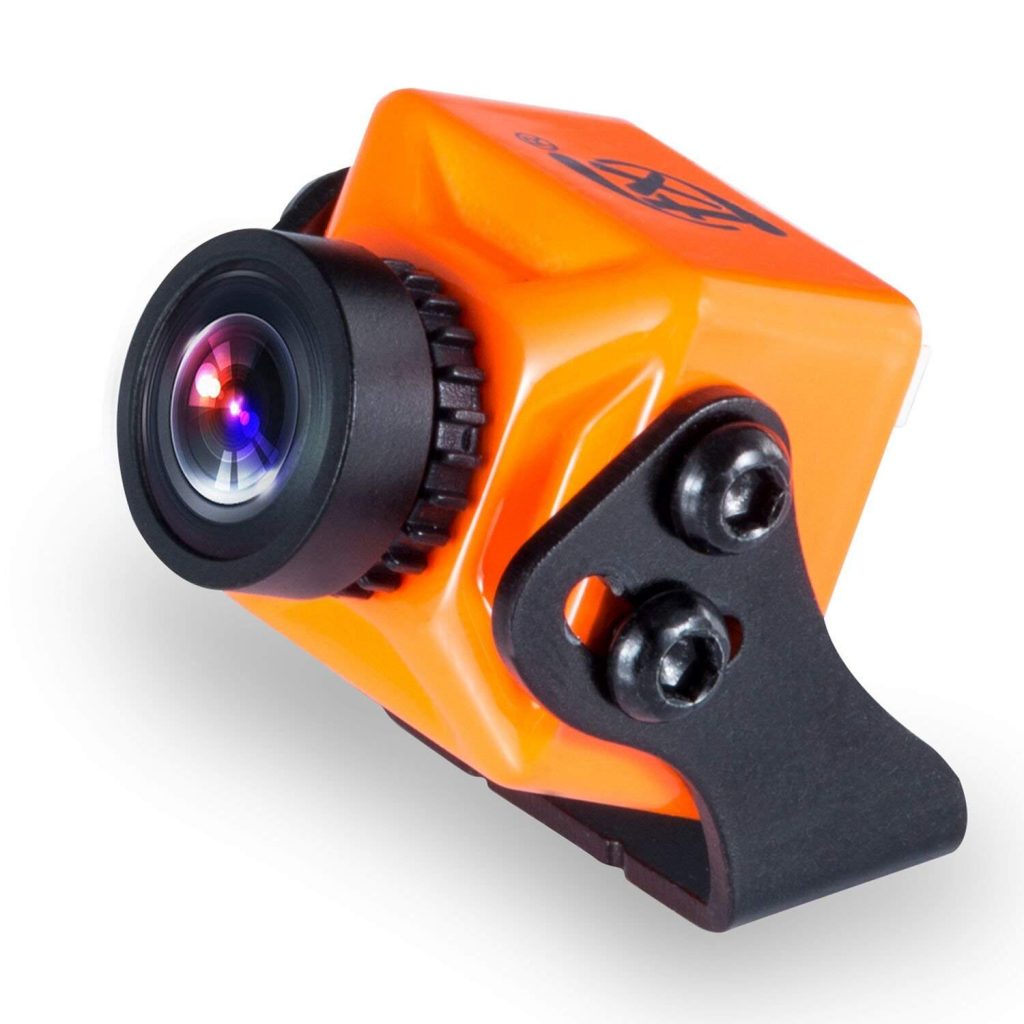
Introducing the FXT Mars S T71, easy to setup 1000 tvl fpv camera. In a nutshell, it shows me the voltage and that is a big win for me. The color production and sharpness not so much.
This little camera comes in various colors and displays the voltage balance on screen. Orange and red color is an added advantage to help me locate a lost camera in an open field. Wide-angle, as I can see the cockpit from the wing, on a plane.
 Input voltage DC4.8V to 36V allows me to safely power up from the main flight battery or a secondary battery. This camera is super small, about a size of a penny, and lightweight. It is wired ready with a standard JR transmitter signal, ground and power cable. The power cable is separated, so you can power your camera in various ways. However way you decide to power up, keep in mind the screen will display the voltage, a useful feature that is built-in…
Input voltage DC4.8V to 36V allows me to safely power up from the main flight battery or a secondary battery. This camera is super small, about a size of a penny, and lightweight. It is wired ready with a standard JR transmitter signal, ground and power cable. The power cable is separated, so you can power your camera in various ways. However way you decide to power up, keep in mind the screen will display the voltage, a useful feature that is built-in…
F2S Autopilot GPS OSD RSSI All-In-One Flight Controller
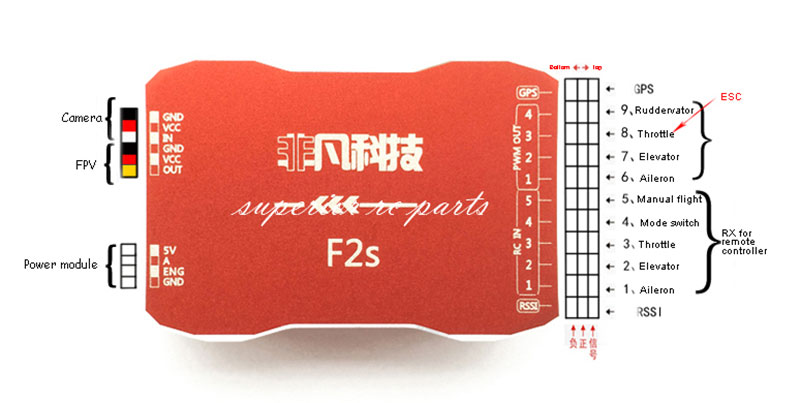
Amazing F2S all-in-1 flight controller, I think this is worth sharing. The F2S coverts your fixed wing planes into a drone with GPS return home. In addition, it adds all the telemetry information on your screen. Best of all, no tuning needed.
We configure the F2S on an Eachine Mini Skyhunter Racer for this episode with a Mobius Mini. It does a nice turn on Return Home and circles in a 8 formation upon returning and begins to climb that 328 ft (100 m) preset. I have been flying this plane without Gyro, so at Manual mode, I still retain the full experience and know I can bail out at any time. The Mini Skyhunter is a fast plane, I noticed the Heading Mode seem to zigzag-drift occasionally, other than that, the rest is good so far. I get the most 11 GPS satellites so far. Here is a video of everything you need to get setup.
 Configurations: You can get to the setups menus, by holding down the Aileron stick to the right for 3 seconds and the menus will pop up. Please note that if you have any weight (trims) adjusted to the ailerons inputs, you may not be able to reach the menus. If you flying a 3 or 4 channel airplane, make sure you set the type to plane icon on the F2S, if needed connect your Rudder directly to your receiver. You can connect Ailerons by using a Y connector on to the PWM Out #6.
Configurations: You can get to the setups menus, by holding down the Aileron stick to the right for 3 seconds and the menus will pop up. Please note that if you have any weight (trims) adjusted to the ailerons inputs, you may not be able to reach the menus. If you flying a 3 or 4 channel airplane, make sure you set the type to plane icon on the F2S, if needed connect your Rudder directly to your receiver. You can connect Ailerons by using a Y connector on to the PWM Out #6.
If you are flying a Delta Wing, connect one Aileron to PWM Out1 and the other Aileron to PWM Out #7, set the type to Delta Wing icon. The F2S will configure them as Elevons.
Pros – can be installed and tested under an hour, multiple flight modes and comprehensive OSD
Limitations or maybe good – little customization or tuning available or needed. Setup by radio, no computer required…
ODRVM 4k FPV camera

The latest actions sports camera ODRVM 4k talks. We took it out to compare with the Git2 camera. Here are some sampling of footage filmed at Disney. These ultra vivid cameras are becoming very affordable these days.
The ODRVM comes with in a very nice case with accessories, a user guide in 4 languages. It comes with a remote controller, a great way to start/stop a recording from the distance or when the camera is placed in a location not easily reachable.
User Segment
Camera Enthusiast, Budget $69 (May 2017 source: Amazon)
Our Notes
Lets take a look at the camera. On the front we have the power and mode button. The shutter/recording button is on the top with a LED indicator. By placing the LED indicator on the top, helps to prevent a blinking reflection while filming closeups and through a window. The back contains the 2″ LCD screen for framing shots. Battery compartment is at the bottom. Right side has the button that allows you to scroll up and down button, a speaker and the WiFi on and off button. On the left side has a micro USB, micro HDMI output, microphone, and a micro SD slot.
It is slightly bigger than a GoPro 3, but is actually lighter, weighing just 63 grams.
The details are sharp, colors are vibrant. The ODVRM has an excellent wide dynamic range, even when a subject is backlit by the sun, you can usually see their face. The saturation is good without looking over-done.
The white balance on the camera adds colors to balance the light source, for example on a overcast day, the image can look bluish if left unadjusted. This auto white balance control in your camera sees the cool color temperature and adds some red to warm the colors, as a result you may see a tint of red.
The menu system is straight forward, simple to use and intuitive. The settings selected are displayed on the screen which is absolutely useful to view before you begin filming.
Voice prompt can be useful in some situations, it prompts you when your battery is low and each time you start and stop recording. You may find yourself turning it off after a while, unless you plan to edit out every voice prompt on the recorded videos.
The field of view options are 170, 140, 110 and 70. Anti-shaking and gyroscope is available as a option.
A feature we like is the auto time-lapse, a mood feature to capture moments in time.
The maximum photo size is 20m and UHD 4K video at 24 fps or more popular at 1080p 60 fps or 720p at 120 fps.
Filming at 4k is sharp, but not as smooth, and that seem to the same problem with the Git2.
Similar Models
Users have considered these 2017 alternatives: Git2, Firefly 6s
Factory Specifications
- Video Resolution: 4K 24fps; 2K 30fps; 1080P 60fps; 720p 120 fps; 720p 60 fps
Image Resolution: 20M, 16M, 12M, 10M, 8M, 5M, 2M , VGA selectable
Lens: 170°/140°/110°/70° selectable
Shooting Mode: Single Shot / Self-timer (2S / 5s / 10s / Double)
Time-lapse Record: 100ms / 200ms / 500ms / 1Sec / 5 Sec
Loop recording: Support
Voice prompt: Support
Motion Detection: Support
Frequency: 50Hz/60Hz
USB Interface: micro USB 2.0, micro HDMI
Power Source Interface: 5V/1A
Battery Capacity: 3.7V Li-ion Battery 1050 mAh (Two Batteries Included )
Recording Time per battery: 40 minutes/ UHD 24 fps, 60 minutes/1080P 30fps , 70 minutes/720p 120fps
Operating System (OS): Windows XP/Vista or Above/Win7/Mac os
In terms of ranking, I would say it is in the top 4 favorites during this release recorded May 2017. An update to follow. (Current Picks dronemission.com/top5)
Eachine VR D2 Pro Focus Adjustable
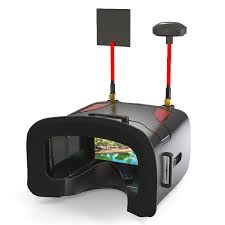
Just over 3 years ago, we had a challenge finding an affordable pair of goggles for FPV, let alone a DVR. Eachine VR D2 Pro Upgraded Goggle delivers an All-In-One (AIO) solution with built-in diopter correction lens, a DVR, dual diversity receivers, with RSSI, includes a tripod mount and best of all within budget
This is what I have been waiting for, corrective lenses for people who wear glasses, nearsighted, this helps just a little, I wouldn’t say it is compatible for everyone, but I can now read the osd without glasses having been using -2.0 diopter on all my other goggles. I have the lens slide all the way to the front. There is a slider on the left and right, and you just adjust it to best fit your eyes.
User Segment
FPV Piloting, Off the shelves. Budget [$] (PRICE CHECK: $89.99 ■ May 2017 Arthur’s Pick)
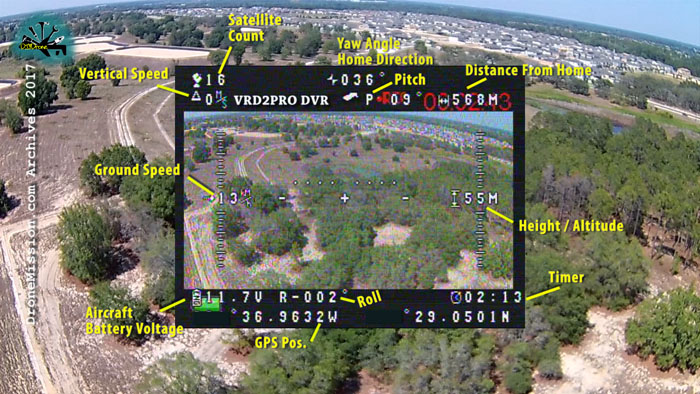
What To Expect
The menu system is broken down into 5 sections.
What I like about the upgraded functions are the On Screen Display (OSD) and Recieved Signal Strength Indicator (RSSI). The voltage of the goggle battery and frequency selection is shown; it is not recorded, but overlays on your screen. It is suggested that we calibrate the RSSI before each flight. The A&B signal strength helps me identify the direction of a lost aircraft to some accuracy, as you can hold the goggle against your chest and rotate around, and then foolow the direction with the strongest signal.
It accepts upto 64 gb of memory storage and records at 16000 kbps Bitrate at 29.97 fps.
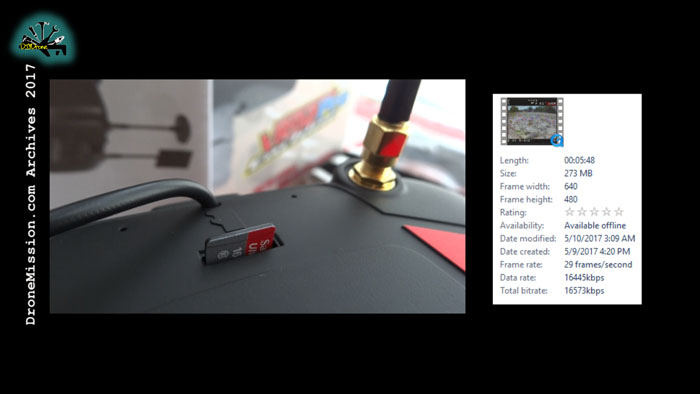
Competitors / Similar Models
Users have considered these 2017 alternatives: Eachine Goggles2, Walkera Goggle4, Kylin Vision
Factory Specifications
Screen size: 5 inches
Screen resolution: 800×480
Record : VGA(640*480),D1(720*480),HD(1280*480)
Frequency channel: built-in 40CH 5.8GHz receiver
Battery : 2S 7.4-8.4V Lipo battery
Battery duration: 2.5 hours
Antenna connector: RP-SMA
Mushroon Antenna : RHCP, 6dBi
Panel Antenna : 6dBi
DVR Max Support: 64G SD Card
Goggles weight: 285g (without antenna)
About Eachine http://dronemission.com/youtube/eachine/
Frsky Horus X12S
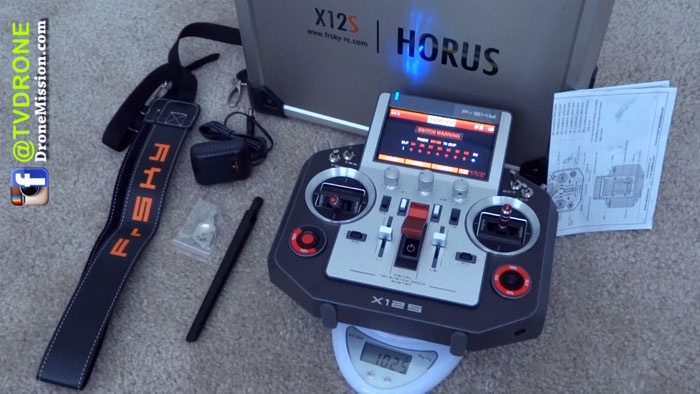
Frsky Horus X12S radio transmitter, 16-32 channel system, is built to make you the God of the Sky, just like the Egyptian God Horus. Just tilt the transmitter to facilitate auxiliary control as there is a built-in 6-axis sensor. Includes Voice Alerts for things like; audible count down timers, low voltage warnings, landing gear down warnings etc., just about anything can be programmed and with full telemetry capability and GPS. ■ by dronemission.com
User Segment
Keen Hobbyist, Pro Radio Transmitter, Collectors, Budget [$$] (PRICE CHECK ■ Nov 2016 Arthur’s Pick at Banggood)
First Impression, the material used is heavy-weight milled CNC aluminum, like a military-grade version of the popular Frsky Taranis. It is impact resistance, weight just under 3 pounds. The sticks equipped with six ball bearings for precision and durability. A lot of programming features to keep you up learning and discovering.
What To Expect
It may be overwhelming at the first, but take your time to explore features of a Horus. One of the best features of the Horus is its full telemetry capability, as well as RSSI signal strength feedback, there are 3 different programmable failsafe modes and receiver lock, so no more crashes due to selecting the wrong model. If you have stock in other brand receivers or B&F’s, no worries the Horus has a JR style RF module slot, so you have the option of other brand modules such as the Orange DSM2/DSMX or Open LRS 433mhz module. An inbuilt GPS module helps your model know where you are at all times, making it easier to return to you.
Similar Models
Users have considered these 2016 alternatives: Frsky Taranis
Factory Specifications
Brand: Frsky
Item Name: Horus
Number of Channels: 16CH / up to 32CH
Operating Voltage Range: 7~15V (2s,3s lipos acceptable)
Backlight LCD Screen: 480*272, high resolution TFT color screen
Model Memories: 60 (expandable with SD card)
Advance Functions: Full telemetry capability inbuilt GPS module
Gyro: 6-axis sensor (3-axis gyro and 3-axis accelerator)
Trainer: Inbuilt wireless trainer system
Compatibility: FrSky X series, D series, L series and V8-II series receivers
What we love about it
- Audible count down timers
- Audible programming
- Low voltage warnings
What is essential we hope to see in the next version
- FPV video screen and DVR
In terms of ranking, I would say it is in the top 7 favorites during this release recorded November 2016. An update to follow
360 FPV videos
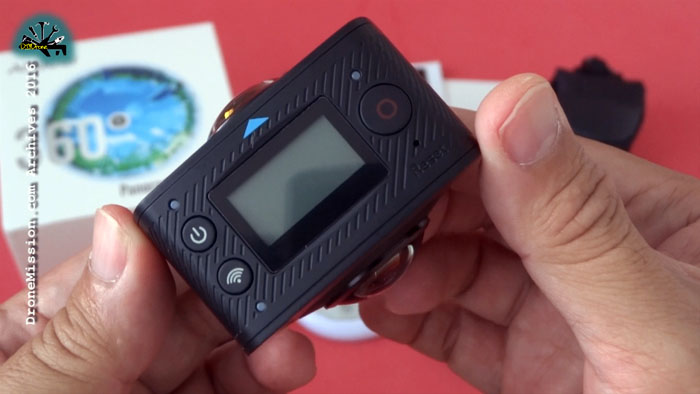
What the Andoer Dual-lens 360°, Ricoh Theta S and Samsung Gear 360 have in common are the dual-lenses that allows you to film and upload 360-degree videos. This give rise to a new perspective if drone aerial first person view
YouTube and Facebook now supports uploading and playback of 360° spherical videos. To watch 360° videos, you need the latest version of Chrome, Opera, Firefox, or Internet Explorer on your computer. On mobile devices, use the latest version of the YouTube app for Android or iOS.
(Best viewed in 360 youtube app or goggle directly by opening this link https://youtube.com/360)
For an immersive experience, you can even watch 360° videos with a cardboard goggle attaching the YouTube Android app.
After a week of filming, we begin to discover that is just a few things to consider before creating the video.
- Decide the best way to mount the camera without appearing to be holding a tripod (you likely don’t want to be showing your crown, if you realized you are being filmed no matter where you stood in 360).
- What if you want to incorporate text on the video or include a logo, not knowing if your audience is looking front, back, sides, down or up.
- Storyboarding and sequencing scenes in 360. How do you mix 2D and 360 footages?
The following 360 cameras are compatible with YouTube and are available today:
• Andoer Dual-lens 360° (budget $125 source: Nov 2016 camfere.com)
• Ricoh Theta S
• Samsung Gear 360
For the best results, encode your video at a high resolution and according to YouTube’s advanced specifications. YouTube currently supports 360° videos with 24, 25, 30, 48, 50, or 60 frames per second. We recommend uploading 16:9 aspect ratio stitched videos in 4K (3840×2160) resolution as a loss of resolution is inevitable when playback in youtube 360. A 1080p video, when stretçhed and wrapped around the sphere will look like 480p.
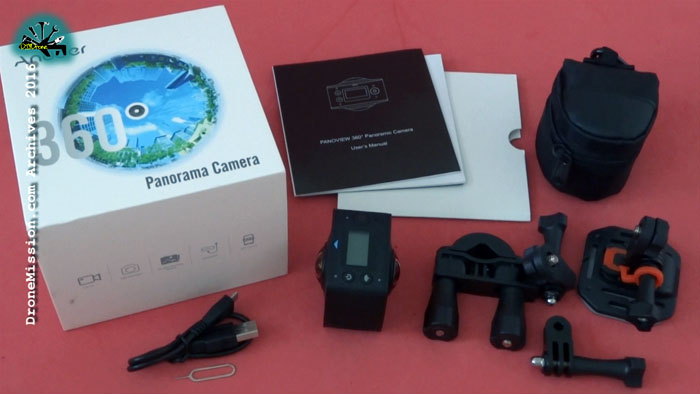
When uploading your 360° video, don’t make edits to the video using the YouTube Video Editor and Enhancements tools on desktop or mobile. These tools don’t currently support 360° videos.
Before publishing, schedule the video for a later date and verify that the file has 360° playback enabled by watching the video on your device. It may take up to 30 minutes for 360° playback to be processed after uploading.
360° videos on a browser feature a pan button in the top left, and can be rotated using the WASD keys, so look for these features to confirm your video is in 360.
If you take the video straight out of the camera and try to upload it to Youtube, it’s not going to work properly. The video will upload and be available, but when you go to view it you’ll see a stereoscopic image–an odd-looking video of side-by-side circles, each showing the hemisphere captured by one of the two lenses.

To make it work properly there are two steps you have to do before uploading it.
1. You will need to convert the image from stereoscopic view to an equirectangular one. That will combine the two hemispheres into a wide view with dimensions where the width is exactly double the height (otherwise known as a 2:1 aspect ratio). And the tops and bottoms of the frames will look strange and stretched. But when used in a specialized 360° player those stretched parts of the frame will fill out when you look up or down, wrapping around the sphere 360.
If you own the budget Andoer 360 camera, you can use the recommended unregistered Symax 360 software – Open Convertor, set Video Quality = High, Start.
2. In order to upload and playback a 360° video file, you’ll need to modify the metadata of the video file with an app or script before uploading.
Follow these instructions to install an app that will add the necessary metadata into a new file for you.
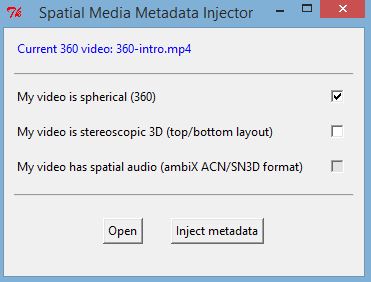
- Download the 360 Video Metadata app for Mac or Windows recommended by YouTube
- Un-zip the file, then open the 360 Metadata Injector app. If you’re on a Mac, you may need to right-click the app and then click Open.
- You can also add the metadata using a Python script.
- Select the original or edited 360 video file
- Select the checkbox for My Video is Spherical (360) and click Inject Metadata. Do not select the “3D Top-bottom” checkbox. For more information, refer to upload instructions for virtual reality videos.
- Save the file that will be created suffix with “injected.mp4”.
- Save the file. A new file will be created automatically in the same location as the original file.
- Upload the new injected file to YouTube.
- Wait for the 360° conversion to process. This may take up to 30 minutes for a 7 minutes video.
Tip: Andoer Dual-lens 360° 960p on Premiere Pro, follow 1920x 960 size, h.264
Mobius Mini Camera
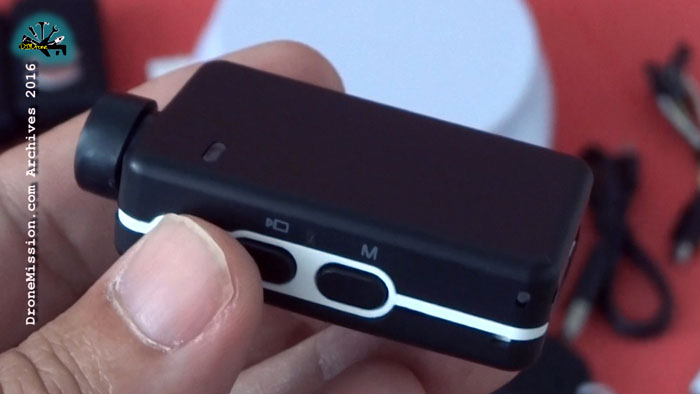
Mobius Mini at 27 grams is a major achievement, filming at 1080p 60fps with an amazingly low latency for FPV. You can almost add this mobiusmini camera to any 150 size quadcopter or 800mm airplane. We took it for a test flight, compare it with the FireflyQ6, unbox it and review the design.
Wow… MobiusMini has a very low latency! had a good flight with the mini and have included the latency test results. Says a fraction of a thousandth of a second, subject to your own interpretation. See for yourself and pause your screen to subtract. A snapshot is a frame in time, regardless of what you are viewing with.








